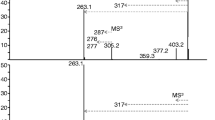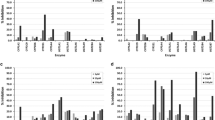Summary
To elucidate the disparity between glucuronidation rates in vivo and UDP-glucuronyltransferase in vitro after CCl4 injury, the time course of the effects of CCl4 (0.25 ml/kg) on kinetic properties of UDP-glucuronyltransferase (l-naphthol as substrate) was examined in rat liver homogenates and microsomes. These experiments were compared with 1-naphthol glucuronidation by the perfused liver which was studied at various time points after CCl4 administration. Phenobarbital-treated rats were used to enhance the hepatotoxicity of CCl4.
-
1.
Within 24 h UDP-glucuronyltransferase activity increased 8-fold in liver homogenates and 3-fold in microsomes. During this time the allosteric activator, UDP-N-acetylglucosamine, lost its effect whereas the inhibitor UDP showed greater inhibitory properties, thus counteracting the activation.
-
2.
1-Naphthol glucuronidation in perfused livers was significantly decreased by 24 h. Sulfate ester formation was little affected.
-
3.
The content of UDP-glucuronic acid was not significantly altered although liver histology revealed about 45% necrotic and prenecrotic cells and an uniform fatty degeneration of hepatocytes after 24 h.
The results suggest that during CCl4 injury, UDP-glucuronyltransferase is activated. At the same time the kinetic properties of the enzyme are altered in a way leading to inefficient glucuronide synthesis, when assays are carried out under conditions presumed to exist in vivo. Nevertheless the capacity to form glucuronides is retained in the acutely injured liver.
Similar content being viewed by others
References
Bock, K. W.: Oxidation of barbiturates and the glucuronidation of 1-naphthol in perfused rat liver and in microsomes. Naunyn-Schmiedeberg's Arch. Pharmacol. 283, 319–330 (1974)
Bock, K. W., White, I. N. H.: UDP-glucuronyltransferase in perfused rat liver and in microsomes: Influence of phenobarbital and 3-methylcholanthrene. Europ. J. Biochem. 46, 451–459 (1974)
Bock, K. W., Fröhling, W., Remmer, H., Rexer, B.: Effects of phenobarbital and 3-methylcholanthrene on substrate specificity of rat liver microsomal UDP-glucuronyltransferase. Biochim. biophys. Acta (Amst.) 327, 46–56 (1973)
Dutton, G. J.: The biosynthesis of glucuronides. In: Glucuronic acid, Free and Combined (G. J. Dutton, ed.), pp. 185–299. New York: Academic Press 1966
Dutton, G. J.: Glucuronide-forming enzymes. Handb. exp. Pharm., 28 (2), pp. 378–400. Berlin-Heidelberg-New York: Springer 1971
Dutton, G. J.: Control of UDP-glucuronyltransferase activity. Biochem. Pharmacol. 24, 1835–1841 (1975)
Garner, R. C., McLean, A. E. M.: Increased susceptibility of carbon tetrachloride poisoning in the rat after pretreatment with oral phenobarbital. Biochem. Pharmacol. 18, 645–650 (1969)
Isselbacher, K. J., Chrabas, M. F., Quinn, R. C.: The solubilization and partial purification of a glucuronyltransferase from rabbit liver microsomes. J. biol. Chem. 237, 3033–3036 (1962)
Keppler, D. O. R., Rudigier, J. F. M., Bischoff, E., Decker, K. F. A.: The trapping of uridine phosphates by d-galactosamine, d-glucosamine and 2-deoxy-d-galactose. Europ. J. Biochem. 17, 246–253 (1970)
Levvy, G. A.: The preparation and properties of β-glucuronidase. Biochem. J. 52, 464–472 (1952)
Lucier, G. W., McDaniel, O. S., Matthews, N. B.: Microsomal rat liver UDP-glucuronyltransferase. Arch. Biochem. Biophys. 145, 520–530 (1971)
Omura, T., Sato, R.: The carbon-monoxide-binding pigment of liver microsomes. J. biol. Chem. 239, 2370–2385 (1964)
Otani, G., Abou-El-Makarem, M. M., Bock, K. W.: UDP-glucuronyltransferase in perfused rat liver and in microsomes: III. Effects of galactosamine and carbon tetrachloride on the glucuronidation of 1-naphthol and bilirubin. Biochem. Pharmacol. 25, 1293–1297 (1976)
Recknagel, R. O.: Carbon tetrachloride hepatotoxicity. Pharmacol. Rev. 19, 145–208 (1967)
Winsnes, A.: Studies on the activation in vitro of glucuronyltransferase. Biochim. biophys. Acta (Amst.) 191, 279–291 (1969)
Winsnes, A.: Inhibition of hepatic UDP-glucuronyltransferase by nucleotides. Biochim. biophys. Acta (Amst.) 289, 88–96 (1972)
Winsnes, A., Dutton, G. J.: Comparison between o-aminophenol glucuronidation in liver slices and homogenates from control and phenobarbital-treated Wistar and Gunn rats. Biochem. Pharmacol. 22, 1765–1771 (1975)
Vessey, D. A., Goldenberg, J., Zakim, D.: Kinetic properties of microsomal UDP-glucuronyltransferase. Biochim. biophys. Acta (Amst.) 309, 58–66 (1973)
Zakim, D., Vessey, D. A.: The effects of lipid-protein interactions on the kinetic parameters of microsomal UDP-glucuronyltransferase. In: The Enzymes of Biological Membranes, Vol. 2 (A. Martonosi, ed.), pp. 443–461. New York: Plenum Press 1976
Author information
Authors and Affiliations
Rights and permissions
About this article
Cite this article
Bock, K.W., Huber, E. & Schlote, W. UDP-Glucuronyltransferase in perfused rat liver and in microsomes. Naunyn-Schmiedeberg's Arch. Pharmacol. 296, 199–203 (1977). https://doi.org/10.1007/BF00498686
Received:
Accepted:
Issue Date:
DOI: https://doi.org/10.1007/BF00498686




